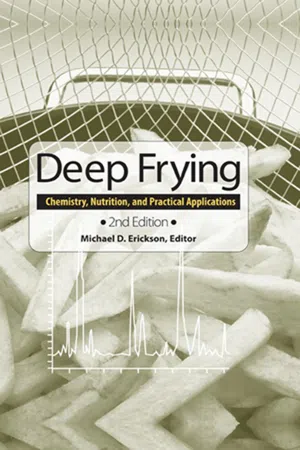
This is a test
- 464 pages
- English
- ePUB (mobile friendly)
- Available on iOS & Android
eBook - ePub
Book details
Book preview
Table of contents
Citations
About This Book
Since the first edition of Deep Frying was published in 1996, there have been many changes to the U.S. Dietary Guidelines and nutritional labeling laws, and improvements in frying technology and practices have made a significant impact on the industry. This book covers everything you need to know to create fat and oil ingredients that are nutritious, uniquely palatable and satisfying.
- Focuses heavily on the physical characteristics of oils during frying, including odor and flavor components and oxidized sterols
- Includes practical information on the dynamics of frying from many perspectives including foodservice and industrial
- Addresses regulatory issues, environmental concerns, and nutritional aspects
Frequently asked questions
At the moment all of our mobile-responsive ePub books are available to download via the app. Most of our PDFs are also available to download and we're working on making the final remaining ones downloadable now. Learn more here.
Both plans give you full access to the library and all of Perlego’s features. The only differences are the price and subscription period: With the annual plan you’ll save around 30% compared to 12 months on the monthly plan.
We are an online textbook subscription service, where you can get access to an entire online library for less than the price of a single book per month. With over 1 million books across 1000+ topics, we’ve got you covered! Learn more here.
Look out for the read-aloud symbol on your next book to see if you can listen to it. The read-aloud tool reads text aloud for you, highlighting the text as it is being read. You can pause it, speed it up and slow it down. Learn more here.
Yes, you can access Deep Frying by Michael D. Erickson in PDF and/or ePUB format, as well as other popular books in Technology & Engineering & Food Science. We have over one million books available in our catalogue for you to explore.
Information
Part 1
Overview
1
Production and Composition of Frying Fats
David R. Erickson, DJ Consultants, 507 Woodlake Drive, Santa Rosa, CA 95405-9203
Production of suitable frying fats and oils starts with crude fats or oils extracted from oil seeds, tree fruits and nuts, and animal or marine fatty tissues. In this chapter the successive steps of extraction, refining and formulation of fats and oils into frying media will be briefly discussed.
Composition of Crude Fats and Oils
Fats and oils are considered less complex than proteins and carbohydrates because they consist largely of triacylglycerols (triglycerides), which are relatively simple compounds. Nevertheless, there are some common conventional terms used in the edible oils industry that may be somewhat confusing.
The first of these are the actual definitions of fats and oils. The classic definition for fats is that they are solid at room temperature (20°C), while oils are liquid. Table 1.1 shows, however, that classic definitions do not necessarily agree with common usage. More confusion is introduced when fats and oils such as cottonseed, palm, lard, and tallow, are fractionated to give lower-melting, liquid, or soft fractions (olein), and higher-melting, more solid fractions (stearine). Such fractionations and their products are shown in Table 1.2. Further uncertainty is introduced depending on the degree and efficiency of fractionation.
TABLE 1.1
Fats and Oils by Classic Definitions Compared to Common Usage
| Oil (liquid at 20°C) | Fat (solid at 20°C)a |
| Corn | Coconut |
| Cottonseed | Palm |
| Fish | Palm kernel |
| Olive | Butter (butter oil) |
| Peanut | Lard (lard oil) |
| Rapeseed/canola | Tallow (oleo oil) |
| Safflower | |
| Soybean | Sunflower |
aAll are solid or partially solid at room temperature.
TABLE 1.2
Fractionated Fats/Oils and Resulting Products
| Product | Fraction |
| Cottonseed | Winterized cottonseed oil |
| Cottonseed stearine |
Table of contents
- Cover image
- Title page
- Table of Contents
- Copyright
- Dedication
- Foreword
- Introduction
- About the Editor
- Part 1: Overview
- Part 2: Physical Characteristics
- Part 3: Nutrition
- Part 4: Application
- Part 5: Evaluation
- Part 6: Regulation
- Index